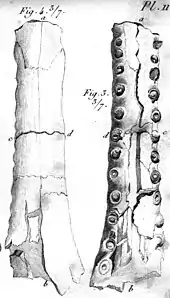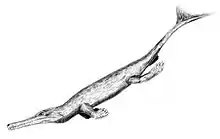Steneosaurus
Steneosaurus (from Greek: στενός stenós, 'narrow' and Greek: σαῦρος saûros, 'lizard')[1] is a dubious genus of teleosaurid crocodyliform from the Middle or Late Jurassic (Callovian or early Oxfordian) of France. The genus has been used as a wastebasket taxon for thalattosuchian fossils for over two centuries, and almost all known historical species of teleosauroid have been included within it at one point. The genus has remained a wastebasket, with numerous species still included under the label ‘Steneosaurus’, many of which are unrelated to each other (either paraphyletic or polyphyletic with respect to each other and other genera of teleosauroids).
| Steneosaurus | |
|---|---|
 | |
| Lectotype snout | |
| Scientific classification | |
| Domain: | Eukaryota |
| Kingdom: | Animalia |
| Phylum: | Chordata |
| Class: | Reptilia |
| Clade: | Pseudosuchia |
| Clade: | Crocodylomorpha |
| Suborder: | †Thalattosuchia |
| Superfamily: | †Teleosauroidea |
| Genus: | †Steneosaurus Geoffroy, 1825 |
| Type species | |
| †Steneosaurus rostromajor Geoffroy, 1825 | |
| Synonyms | |
|
Synonyms of Steneosaurus
Synonyms of S. rostromajor:
| |
Discovery and assigned species

The type species, S. rostromajor, was only formally recognised as such in 2020, and this revision determined the type specimen of Steneosaurus was undiagnostic, and so declared the genus Steneosaurus a nomen dubium.[2] The history of this specimen has been detailed in 2017.[3] It was discovered in three pieces by abbot Charles Bacheley (1716-1795) in the Vaches Noires near Villers-sur-Mer (Calvados, France).[4] Bacheley offered these pieces to Alexandre Besson (1725-1809) who had built up an important cabinet of fossils and minerals in Paris. Besson gave one of the pieces (the posterior portion) to Barthélémy Faujas de Saint-Fond (1741-1819), professor of geology in the Muséum national d'Histoire naturelle, Paris. Georges Cuvier first illustrated in 1808 the two anterior pieces of the specimen kept in the Besson collection and then figured the third piece (posterior portion from the Faujas de Saint-Fond collection) in 1824 in association with the anterior pieces (Besson collection) and other cranial remains belonging to Metriorhynchidae.
The remaining species referred to Steneosaurus thus require new generic names, and some species have already been assigned to new genera prior to Steneosaurus being declared a nomen dubium.[2]
Species in this genus are traditionally classed into two skull groups: longirostrine (long, narrow jaws) and mesorostrine (slightly shorter jaws).
- Longirostrine
- 'S.' atelestatus Eudes-Deslongchamps, 1868[5] - Oxfordian Marnes de Villers of France
- 'S.' blumembachi Eudes-Deslongchamps, 1868[6] - Oxfordian Marnes de Villers of France
- 'S.' oplites Eudes-Deslongchamps, 1863[7] - Toarcian La Caine-Curcy of France
- 'S.' rudis Sauvage, 1874[8] - France
Reassigned species
- 'Steneosaurus' baroni Newton, 1893 = Andrianavoay
- 'Steneosaurus' bollensis Von Meyer, 1830 = Macrospondylus
- 'S.' bouchardi - Sauvage, 1872 = Proexochokefalos
- 'Steneosaurus' boutilieri Eudes-Deslongchamps, 1869 = Yvridiosuchus[9]
- 'Steneosaurus' brevior Blake, 1876 = Mystriosaurus
- 'Steneosaurus' deslongchampsianus (Lennier, 1887)[10]
- 'Steneosaurus' edwardsi (Eudes-Deslongchamps, 1868) = Neosteneosaurus
- 'Steneosaurus' gracilirostris (Westphal, 1961) = Plagiophthalmosuchus
- 'Steneosaurus' heberti Morel de Glasville, 1876 = Proexochokefalos
- 'Steneosaurus' larteti (Eudes-Deslongchamps, 1868) = Deslongchampsina[9]
- 'Steneosaurus' leedsi (Andrews, 1909) = Charitomenosuchus
- 'Steneosaurus' megarhinus (Hulke, 1871) = Bathysuchus[11][12]
- 'Steneosaurus' megistorhynchus (Geoffrey Saint-Hilaire in Eudes-Deslongchamps, 1869) = Seldsienean
- 'Steneosaurus' obtusidens Andrews, 1909 = Lemmysuchus
Classification
A 2005 phylogenetic analysis into the evolutionary relationships of Thalattosuchia did not support the monophyly of Steneosaurus, as the genera Machimosaurus and Teleosaurus both fell within Steneosaurus.[13] Reinforcing the paraphyly of Steneosaurus, the Callovian species "Steneosaurus" obtusidens has been recovered as the sister species of Machimosaurus in recent cladistic analyses of Thalattosuchia and renamed Lemmysuchus, while 'Steneosaurus' bollensis was recovered in a basal position to other members of Steneosaurus sensu lato.[14][15]
See also
References
- Roberts, George (1839). An etymological and explanatory dictionary of the terms and language of geology. London: Longman, Orme, Brown, Green, & Longmans. p. 162. Retrieved 1 January 2022.
- Johnson, Michela M.; Young, Mark T.; Brusatte, Stephen L. (2020). "Emptying the wastebasket: a historical and taxonomic revision of the Jurassic crocodylomorph Steneosaurus". Zoological Journal of the Linnean Society. 189 (2): 428–448. doi:10.1093/zoolinnean/zlaa027.
- Brignon, A. (2017). "Les " ossements pétrifiés " du Jurassique des Vaches Noires dans les cabinets d'histoire naturelle du XVIIIe et du début du XIXe siècles". L'Echo des Falaises, revue de l'Association paléontologique de Villers-sur-Mer (21): 7–35.
- Brignon, A. (2016). "L'abbé Bacheley et la découverte des premiers dinosaures et crocodiliens marins dans le Jurassique des Vaches Noires (Callovien/Oxfordien, Normandie)". Comptes Rendus Palevol. 15 (5): 595–605. Bibcode:2016CRPal..15..595B. doi:10.1016/j.crpv.2015.10.004.
- Steneosaurus atelestatus at Fossilworks.org
- Steneosaurus blumembachi at Fossilworks.org
- Steneosaurus oplites at Fossilworks.org
- Steneosaurus rudis at Fossilworks.org
- Johnson, Michela M.; Young, Mark T.; Brusatte, Stephen L. (2019). "Re-description of two contemporaneous mesorostrine teleosauroids (Crocodylomorpha: Thalattosuchia) from the Bathonian of England and insights into the early evolution of Machimosaurini". Zoological Journal of the Linnean Society. 189 (2): 449–482. doi:10.1093/zoolinnean/zlz037. hdl:1842/36656.
- Foffa, Davide; Young, Mark T.; Brusatte, Stephen L. (2018). "Filling the Corallian gap: New information on Late Jurassic marine reptile faunas from England" (PDF). Acta Palaeontologica Polonica. 63: 287–313. doi:10.4202/app.00455.2018. Retrieved 7 March 2019.
- Foffa, D.; Young, M.T.; Brusatte, S.L.; Steel, L. (2015). "New specimen and revision of the late Jurassic teleosaurid 'Steneosaurus' megarhinus". PeerJ Preprints. 3: e1351v1. Retrieved 7 March 2019.
- Foffa, D.; Johnson, M.M.; Young, M.T.; Steel, L.; Brusatte, S.L. (2019). "Revision of the Late Jurassic deep-water teleosauroid crocodylomorph Teleosaurus megarhinus Hulke, 1871 and evidence of pelagic adaptations in Teleosauroidea". PeerJ. 7: e6646. doi:10.7717/peerj.6646. PMC 6450380. PMID 30972249.
- Mueller-Töwe, I. J. (2005). "Phylogenetic relationships of the Thalattosuchia" (PDF). Zitteliana. A45: 211–213.
- Young, M. T.; Brusatte, S. L.; Andrade, M. B.; Desojo, J. B.; Beatty, B. L.; Steel, L.; Fernández, M. S.; Sakamoto, M.; Ruiz-Omeñaca, J. I.; Schoch, R. R. (2012). ""Butler, Richard J, ed. "The Cranial Osteology and Feeding Ecology of the Metriorhynchid Crocodylomorph Genera Dakosaurus and Plesiosuchus from the Late Jurassic of Europe". PLOS ONE. 7 (9): e44985. doi:10.1371/journal.pone.0044985. PMC 3445579. PMID 23028723.
- Martin, J. E.; Vincent, P. (2013). "New remains of Machimosaurus hugii von Meyer, 1837 (Crocodilia, Thalattosuchia) from the Kimmeridgian of Germany". Fossil Record. 16 (2): 179–196. doi:10.1002/mmng.201300009.
